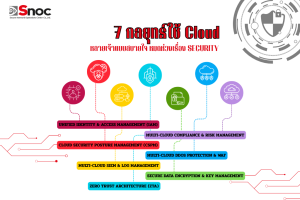ปัจจุบันหลายองค์กรเลือกใช้ Multi-Cloud Strategy หรือการใช้งาน Cloud มากกว่าหนึ่งผู้ให้บริการ เช่น AWS, Azure, Google Cloud, และ Alibaba Cloud เพื่อลดความเสี่ยงจากการพึ่งพาแพลตฟอร์มเดียว (Vendor Lock-in) และเพิ่มความยืดหยุ่นในการดำเนินธุรกิจ อย่างไรก็ตาม การใช้ Multi-Cloud Environment ทำให้เกิด ความซับซ้อนด้านความปลอดภัย ที่ต้องบริหารจัดการอย่างมีประสิทธิภาพ มาดูกลยุทธ์สำคัญในการป้องกันภัยคุกคามสำหรับธุรกิจที่ใช้หลาย Cloud Providers
✅ การจัดการ Identity & Access Control ที่ซับซ้อน – การกำหนดสิทธิ์ผู้ใช้ระหว่าง Cloud Providers ต้องสอดคล้องกัน
✅ การตรวจสอบ Log และ Incident Response – ระบบ Log และ SIEM ต้องรวมศูนย์จากทุก Cloud
✅ Compliance และ Data Governance – ข้อมูลที่เก็บบนหลาย Cloud ต้องเป็นไปตามมาตรฐาน เช่น GDPR, ISO 27001, NIST CSF
✅ ความเสี่ยงจาก API และ Misconfiguration – ช่องโหว่จาก API หรือการตั้งค่าผิดพลาดอาจเปิดโอกาสให้เกิด Data Breach
🚀 กลยุทธ์สำคัญในการรักษาความปลอดภัย Multi-Cloud
📌 ปัญหา: การจัดการสิทธิ์ผู้ใช้ในหลาย Cloud อาจซับซ้อนและเสี่ยงต่อการโจมตีแบบ Credential Theft
✅ กลยุทธ์ที่แนะนำ:
- ใช้ Federated Identity & Single Sign-On (SSO) เช่น Azure AD, Okta, Google IAM
- ใช้ Role-Based Access Control (RBAC) และ Attribute-Based Access Control (ABAC) เพื่อกำหนดสิทธิ์ตามความจำเป็น
- เปิดใช้ Multi-Factor Authentication (MFA) บนทุก Cloud
🔹 ตัวอย่างโซลูชัน:
🔹 AWS IAM + Azure AD + Google IAM Federation
🔹 Okta หรือ Ping Identity สำหรับ SSO
📌 ปัญหา: Cloud Misconfiguration เป็นสาเหตุหลักของ Data Breach
✅ กลยุทธ์ที่แนะนำ:
- ใช้ CSPM Tools เพื่อตรวจสอบและแก้ไขการตั้งค่าที่ผิดพลาดโดยอัตโนมัติ
- ตั้งค่า Security Baselines และ Continuous Compliance Monitoring
🔹 ตัวอย่างโซลูชัน:
🔹 AWS Security Hub, Azure Security Center, Google Security Command Center
🔹 Palo Alto Prisma Cloud, Check Point CloudGuard
📌 ปัญหา: ข้อมูล Log กระจายตัว ทำให้ยากต่อการตรวจสอบและตอบสนองต่อภัยคุกคาม
✅ กลยุทธ์ที่แนะนำ:
- ใช้ Centralized SIEM Solution เพื่อรวบรวม Log จากทุก Cloud
- ตั้งค่าการแจ้งเตือนอัตโนมัติสำหรับกิจกรรมที่น่าสงสัย
- ใช้ AI-driven Threat Detection เพื่อลด False Positives
🔹 ตัวอย่างโซลูชัน:
🔹 Splunk Cloud, Microsoft Sentinel, Google Chronicle
🔹 IBM QRadar, Elastic Security
📌 ปัญหา: Cloud Perimeter Security ไม่สามารถป้องกัน Insider Threat และ Advanced Persistent Threats (APTs) ได้
✅ กลยุทธ์ที่แนะนำ:
- ใช้ Zero Trust Network Access (ZTNA) แทน VPN แบบเดิม
- ใช้ Continuous Authentication & Identity Verification
- ตรวจสอบพฤติกรรมของผู้ใช้แบบเรียลไทม์ด้วย User and Entity Behavior Analytics (UEBA)
🔹 ตัวอย่างโซลูชัน:
🔹 Google BeyondCorp, Microsoft Entra ID, Zscaler Zero Trust Exchange
🔹 Cisco Duo, Palo Alto Prisma Access
📌 ปัญหา: การโจมตี DDoS และ API Exploits อาจเกิดขึ้นจากหลายช่องทาง
✅ กลยุทธ์ที่แนะนำ:
- ใช้ Cloud-based WAF ที่รองรับ Multi-Cloud
- เปิดใช้ AI-driven DDoS Protection เพื่อตรวจจับพฤติกรรมผิดปกติ
- ปกป้อง API ด้วย API Gateway & Rate Limiting
🔹 ตัวอย่างโซลูชัน:
🔹 AWS Shield, Cloudflare WAF, Google Cloud Armor
🔹 Akamai Kona Site Defender, Imperva WAF
📌 ปัญหา: การปกป้องข้อมูลที่กระจายตัวระหว่าง Cloud Providers
✅ กลยุทธ์ที่แนะนำ:
- ใช้ End-to-End Encryption (E2EE) และ Key Management Service (KMS)
- ปรับใช้ Bring Your Own Key (BYOK) เพื่อลดความเสี่ยงจาก Vendor Lock-in
🔹 ตัวอย่างโซลูชัน:
🔹 AWS KMS, Azure Key Vault, Google Cloud KMS
🔹 Thales CipherTrust Cloud Key Manager
📌 ปัญหา: แต่ละ Cloud Provider มีข้อกำหนดด้าน Compliance ต่างกัน
✅ กลยุทธ์ที่แนะนำ:
- ใช้ Automated Compliance Monitoring & Risk Assessment
- ตรวจสอบ GDPR, ISO 27001, NIST CSF, PCI-DSS ในทุก Cloud
🔹 ตัวอย่างโซลูชัน:
🔹 AWS Audit Manager, Microsoft Purview Compliance Manager
🔹 Google Risk Manager, IBM OpenPages
| กลยุทธ์ | ปัญหาที่แก้ไข | โซลูชันที่แนะนำ |
| Unified IAM & SSO | ลดความเสี่ยงจาก Credential Theft | AWS IAM, Azure AD, Okta |
| CSPM (Cloud Security Posture Management) | ป้องกัน Misconfiguration | Prisma Cloud, AWS Security Hub |
| SIEM & Threat Detection | ตรวจสอบภัยคุกคามจากทุก Cloud | Splunk, Microsoft Sentinel |
| Zero Trust & ZTNA | ลด Insider Threat | Google BeyondCorp, Cisco Duo |
| DDoS Protection & WAF | ป้องกัน Web & API Attacks | Cloudflare, AWS Shield |
| Data Encryption & KMS | ป้องกัน Data Breach | AWS KMS, Thales CipherTrust |
| Compliance Automation | ลดความเสี่ยงด้านกฎหมาย | AWS Audit Manager, Microsoft Purview |
✅ Multi-Cloud Security ไม่ใช่แค่การตั้งค่าความปลอดภัยบน Cloud หลายตัว แต่ต้องมีการบริหารจัดการแบบรวมศูนย์
✅ ใช้ AI และ Machine Learning ในการตรวจจับภัยคุกคามและปรับใช้ Zero Trust Security Model
✅ องค์กรต้องเลือกเครื่องมือที่สามารถทำงานข้าม Cloud Providers ได้ เช่น SIEM, CSPM, และ WAF ที่รองรับ Multi-Cloud
💡 หากองค์กรของคุณกำลังใช้ Multi-Cloud อย่าลืมใช้กลยุทธ์เหล่านี้เพื่อปกป้องระบบของคุณจากภัยคุกคามทางไซเบอร์! 🚀


